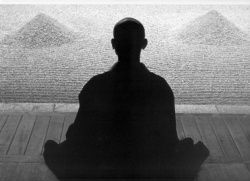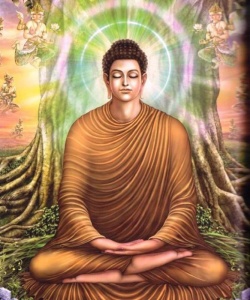Difference between revisions of "Tathatā"
m (Text replacement - "blue" to "blue") |
|||
| (6 intermediate revisions by 3 users not shown) | |||
| Line 1: | Line 1: | ||
| − | [[Tathata]] ([[Sanskrit]], [[Pali]] तथता [[tathatā]]; {{Wiki|Chinese}}: 真如) is variously translated as "thusness" or "[[suchness]]". It is a central {{Wiki|concept}} in [[Buddhism]], and is of particular significance in [[Zen]] [[Buddhism]]. The synonym [[dharmatā]] is also often used. | + | |
| + | |||
| + | |||
| + | |||
| + | |||
| + | |||
| + | [[Tathata]] ([[Sanskrit]], [[Pali]] [[तथता]] [[tathatā]]; {{Wiki|Chinese}}: [[真如]]) is variously translated as "[[thusness]]" or "[[suchness]]". It is a central {{Wiki|concept}} in [[Buddhism]], and is of particular significance in [[Zen]] [[Buddhism]]. The {{Wiki|synonym}} [[dharmatā]] is also often used. | ||
[[File:EK1.jpg|thumb|250px|]] | [[File:EK1.jpg|thumb|250px|]] | ||
| − | |||
| − | In the early texts, it is described as an aspect of nibbānā. | + | |
| + | While alive the [[Buddha]] referred to himself as [[Tathagata]], which can mean either "[[One who has thus come]]" or "One who has [[thus gone]]", and interpreted correctly can be read as "One who has arrived at [[suchness]]". [[Tathatā]] as a central {{Wiki|concept}} of [[Buddhism]] expresses [[appreciation]] of the [[true nature]] of [[reality]] in any given [[moment]]. As no [[moment]] is exactly the same, each one can be savored for what occurs at that precise [[time]], whether it is [[thought]] of as [[being]] "good" or "bad". | ||
| + | |||
| + | In the early texts, it is described as an aspect of [[nibbānā]]. | ||
| + | |||
| + | |||
== [[Tathatā]] in [[Zen]] == | == [[Tathatā]] in [[Zen]] == | ||
| − | In [[Zen]] stories, [[Tathatā]] is often best revealed in the seemingly [[mundane]] or meaningless, such as noticing the way the wind blows through a field of grass, or watching someone's face [[light]] up as they [[smile]]. According to [[Zen]] hagiography, [[Shakyamuni Buddha]] transmitted the [[awareness]] of [[Tathata]] directly to [[Mahakasyapa]] in what has come to be rendered in English as the [[Flower]] Sermon. In another story, [[Shakyamuni]] asked his [[disciples]] "How long is a [[human]] [[life]]?" As none of them could offer the correct answer he told them "[[Life]] is but a [[breath]]". Here we can see the [[Buddha]] expressing the [[impermanent]] nature of the [[world]], where each {{Wiki|individual}} moment is different from the last. As Molloy states, "We know we are experiencing the 'thatness' of [[reality]] when we [[experience]] something and say to ourselves, 'Yes, that's it; that is the way things are.' In the moment, we recognize that [[reality]] is wondrously beautiful but also that its patterns are fragile and passing." | + | |
| + | |||
| + | In [[Zen]] stories, [[Tathatā]] is often best revealed in the seemingly [[mundane]] or meaningless, such as noticing the way the [[wind]] blows through a field of grass, or watching someone's face [[light]] up as they [[smile]]. According to [[Zen]] {{Wiki|hagiography}}, [[Shakyamuni Buddha]] transmitted the [[awareness]] of [[Tathata]] directly to [[Mahakasyapa]] in what has come to be rendered in English as the [[Flower]] {{Wiki|Sermon}}. In another story, [[Shakyamuni]] asked his [[disciples]] "How long is a [[human]] [[life]]?" As none of them could offer the correct answer he told them "[[Life]] is but a [[breath]]". Here we can see the [[Buddha]] expressing the [[impermanent]] [[nature]] of the [[world]], where each {{Wiki|individual}} [[moment]] is different from the last. As Molloy states, "We know we are experiencing the 'thatness' of [[reality]] when we [[experience]] something and say to ourselves, 'Yes, that's it; that is the way things are.' In the [[moment]], we [[recognize]] that [[reality]] is wondrously beautiful but also that its patterns are fragile and passing." | ||
[[File:Lord-Bu.jpg|thumb|250px|]] | [[File:Lord-Bu.jpg|thumb|250px|]] | ||
| − | The natural beauty of the [[world]], and the importance of nature that surrounds us is a key theme in [[Buddhism]]. When asked what [[Zen]] is, many [[masters]] have answered in relation to the features surrounding them: "The {{Wiki|bamboo}} forest, blue skies above the high mountain", etc. Such answers are given to indicate to us that while we are seeking some mysterious answers above and beyond our own understanding of the [[world]], the true way is there for us to see at any moment right in front of our [[eyes]]. The [[zen]] [[master]] [[Thich Nhat Hanh]] wrote "[[People]] usually consider walking on [[water]] or in thin [[air]] a [[miracle]]. But I think the real [[miracle]] is not to walk either on [[water]] or in thin [[air]], but to walk on [[earth]]. Every day we are engaged in a [[miracle]] which we don't even recognize: a blue sky, white clouds, green leaves, the black, curious [[eyes]] of a child--our own two [[eyes]]. All is a [[miracle]]." | + | |
| + | |||
| + | The natural [[beauty]] of the [[world]], and the importance of [[nature]] that surrounds us is a key theme in [[Buddhism]]. When asked what [[Zen]] is, many [[masters]] have answered in [[relation]] to the features surrounding them: "The {{Wiki|bamboo}} {{Wiki|forest}}, blue skies above the high mountain", etc. Such answers are given to indicate to us that while we are seeking some mysterious answers above and [[beyond]] our [[own]] [[understanding]] of the [[world]], the true way is there for us to see at any [[moment]] right in front of our [[eyes]]. The [[zen]] [[master]] [[Thich Nhat Hanh]] wrote "[[People]] usually consider walking on [[water]] or in thin [[air]] a [[miracle]]. But I think the {{Wiki|real}} [[miracle]] is not to walk either on [[water]] or in thin [[air]], but to walk on [[earth]]. Every day we are engaged in a [[miracle]] which we don't even [[recognize]]: a blue sky, white clouds, [[green]] leaves, the black, curious [[eyes]] of a child--our [[own]] two [[eyes]]. All is a [[miracle]]." | ||
== [[Tathatā]] in [[Mahayana]] [[Buddhism]] == | == [[Tathatā]] in [[Mahayana]] [[Buddhism]] == | ||
| − | |||
| − | |||
| − | : The [[Lankavatara]] is always careful to [[balance]] [[sunyata]] with [[Tathatā]], or to insist that when the [[world]] is viewed as sunya, [[empty]], it is grasped in its [[suchness]] | + | The term [[Tathatā]] in the {{Wiki|East Asian}} [[Mahayana]] [[tradition]] is seen as representing the base [[reality]] and can be used to terminate the use of words. A 5th century {{Wiki|Chinese}} [[Mahayana]] [[scripture]] entitled "[[Awakening]] of [[Faith]] in the [[Mahayana]]" describes the {{Wiki|concept}} more fully: "In its very origin [[suchness]] is of itself endowed with [[sublime]] [[attributes]]. It [[manifests]] the [[highest]] [[wisdom]] which shines throughout the [[world]], it has true [[knowledge]] and a [[mind]] resting simply in its [[own]] [[being]]. It is [[eternal]], [[blissful]], its [[own]] [[self-being]] and the purest [[simplicity]]; it is invigorating, immutable, free... Because it possesses all these [[attributes]] and is deprived of [[nothing]], it is designated both as the [[Womb]] of [[Tathagata]] and the [[Dharma]] [[Body]] of [[Tathagata]]." |
| + | |||
| + | [[Robinson]] (1957: pp. 306) echoing Suzuki (1930) conveys how the [[Lankavatara Sutra]] [[perceives]] [[dharmata]] through the portal of [[shunyata]]: | ||
| + | |||
| + | : The [[Lankavatara]] is always careful to [[balance]] [[sunyata]] with [[Tathatā]], or to insist that when the [[world]] is viewed as [[sunya]], [[empty]], it is grasped in its [[suchness]] | ||
| + | |||
| + | |||
| + | |||
| + | |||
{{W}} | {{W}} | ||
| − | + | [[Category:Suchness]] | |
[[Category:Buddhist philosophical concepts]] | [[Category:Buddhist philosophical concepts]] | ||
[[Category:Buddhist Terms]] | [[Category:Buddhist Terms]] | ||
Latest revision as of 19:51, 11 February 2020
Tathata (Sanskrit, Pali तथता tathatā; Chinese: 真如) is variously translated as "thusness" or "suchness". It is a central concept in Buddhism, and is of particular significance in Zen Buddhism. The synonym dharmatā is also often used.
While alive the Buddha referred to himself as Tathagata, which can mean either "One who has thus come" or "One who has thus gone", and interpreted correctly can be read as "One who has arrived at suchness". Tathatā as a central concept of Buddhism expresses appreciation of the true nature of reality in any given moment. As no moment is exactly the same, each one can be savored for what occurs at that precise time, whether it is thought of as being "good" or "bad".
In the early texts, it is described as an aspect of nibbānā.
Tathatā in Zen
In Zen stories, Tathatā is often best revealed in the seemingly mundane or meaningless, such as noticing the way the wind blows through a field of grass, or watching someone's face light up as they smile. According to Zen hagiography, Shakyamuni Buddha transmitted the awareness of Tathata directly to Mahakasyapa in what has come to be rendered in English as the Flower Sermon. In another story, Shakyamuni asked his disciples "How long is a human life?" As none of them could offer the correct answer he told them "Life is but a breath". Here we can see the Buddha expressing the impermanent nature of the world, where each individual moment is different from the last. As Molloy states, "We know we are experiencing the 'thatness' of reality when we experience something and say to ourselves, 'Yes, that's it; that is the way things are.' In the moment, we recognize that reality is wondrously beautiful but also that its patterns are fragile and passing."
The natural beauty of the world, and the importance of nature that surrounds us is a key theme in Buddhism. When asked what Zen is, many masters have answered in relation to the features surrounding them: "The bamboo forest, blue skies above the high mountain", etc. Such answers are given to indicate to us that while we are seeking some mysterious answers above and beyond our own understanding of the world, the true way is there for us to see at any moment right in front of our eyes. The zen master Thich Nhat Hanh wrote "People usually consider walking on water or in thin air a miracle. But I think the real miracle is not to walk either on water or in thin air, but to walk on earth. Every day we are engaged in a miracle which we don't even recognize: a blue sky, white clouds, green leaves, the black, curious eyes of a child--our own two eyes. All is a miracle."
Tathatā in Mahayana Buddhism
The term Tathatā in the East Asian Mahayana tradition is seen as representing the base reality and can be used to terminate the use of words. A 5th century Chinese Mahayana scripture entitled "Awakening of Faith in the Mahayana" describes the concept more fully: "In its very origin suchness is of itself endowed with sublime attributes. It manifests the highest wisdom which shines throughout the world, it has true knowledge and a mind resting simply in its own being. It is eternal, blissful, its own self-being and the purest simplicity; it is invigorating, immutable, free... Because it possesses all these attributes and is deprived of nothing, it is designated both as the Womb of Tathagata and the Dharma Body of Tathagata."
Robinson (1957: pp. 306) echoing Suzuki (1930) conveys how the Lankavatara Sutra perceives dharmata through the portal of shunyata:
- The Lankavatara is always careful to balance sunyata with Tathatā, or to insist that when the world is viewed as sunya, empty, it is grasped in its suchness

